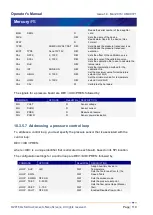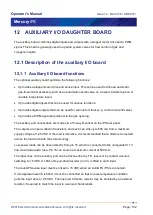
Operator's Manual
Issue 14
/
Mar 2016 / UMC0071
Mercury
iPS
©2016 Oxford Instruments NanoScience. All rights reserved.
Page
128
11.3.2 Resistance measurement in constant current mode
Constant current measurement mode is used with sensors that have a positive temperature
coefficient.
The sensor and a reference resistor (either R44 or R45) are connected in series. Digital to
analogue converters U24 and U25 generate an upper and lower demand voltage. This voltage
is equal to the required current multiplied by the value of the selected reference resistor.
The upper voltage is buffered by U10 and applied to the upper end of the sensor resistor. The
lower voltage is buffered by U15 and applied to the lower end of the reference resistor. The
same current thus passes through the sensor and the reference resistor.
U13 and either U14 or U16 measure the voltage across the reference resistor and pass these
feedback signals back to U10 and U15. This ensures that the voltage across the reference
resistor is exactly equal to the difference between the output voltages of U24 and U25.
The outputs of U13 and either U14 or U16 are also scaled by a reference gain multiplier, whose
gain is selected to give an output in the range 1 V to 2.5 V. This voltage is then passed to the
reference voltage inputs of the ADC (U12). This circuit configuration produces a ratiometric
measurement technique.
The resistance of the sensor is:






























